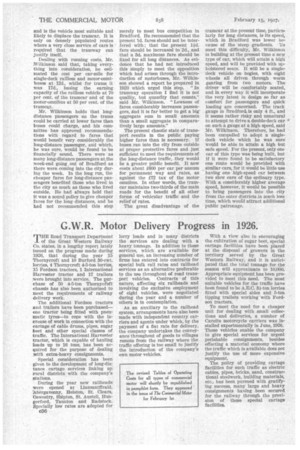G.W.R. Motor Delivery Progress in 1926.
Page 58

If you've noticed an error in this article please click here to report it so we can fix it.
THE Road Transport Department of the Great Western Railway Co. states, in a lengthy report lately issued on the progress made during 1926, that during the year 15 Thornycroft and 10 Burford 30-cwt. lorries, 4 Thornycroft 4-5-ton lorries, 15 Fordson tractors, 1 International Harvester tractor and 17 trailers ;were brought into service. The purchase of 50 4-5-ton Thornyctoft chassis has also been authorized to meet the requirements of railway delivery work.
The additional Fordson tractors and trailers have been purchased— one tractor being fitted with pneurmatic tyres—to cope with the increase of work in connection with the cartage of cable drums, pipes, sugar beet and other special classes of traffic. The International Harvester tractor, which is capable of hauling loads up to 16 tons, has been acquired for the purpose of dealing with extra-heavy consignments.
Special consideration has been given to the development of long-distance cartage services linking up rural districts with the company's stations.
During the year new railheads were opened at Liansantffraid, rAbergavenny, Helston, St. Clears, Oswe-stry, Shipton, St. Austell, Hungerford, Taunton and R.a.dstock. Specially low rates are adopted for o36
lorry loads and in many districts the services are dealing with a heavy tonnage. In addition to these services, which are available for general use, an increasing number a firms has entered into contracts for special bulk rail rates and railhead services as an alternative preferable to the use throughout of road transport vehicles. Contracts of this nature, affecting six railheads and involving the exclusive employment of eight vehicles, were negotiated during the year and a number of others is in contemplation.
As an auxiliary to the railhead system, arrangements have also been made with independent country carriers and agents under which, by the payment of a fiat rate for delivery, the company undertakes the conveyance throughout of goods to villages remote from the railway where the traffic offering is too small to justify the introduction of the company's own motor vehicles. With a view also to encouraging the cultivation of sugar beet, special cartage facilities have been placed at the disposal of growers in the territory served by the Great Western Railway, and it is anticipated that the total tonnage for the season will approximate to 10,000. Appropriate equipment has been provided to meet this need. The most suitable vehicles for the traffic have been found to be A.E.C. 3e-ton lorries fitted with special sides and 5-ton tipping trailers working with Fordson tractors.
To meet the need for a cheaper unit for dealing with small collections and deliveries, a number of Carette motorcycle carriers was installed experimentally in June, 1926. These vehicles enable the company to give special services for urgent perishable consignments, besides effecting a material economy where the traffic which is available does not justify the use of more expensive equipment.
The policy of providing cartage facilities for such traffic as electric cables, pipes, bricks, sand, constructional steelwork, building materials, etc., has been pursued with gratifying success, many large and heavy consignments having been secured for the railway through the provision of these special cartage












































































































